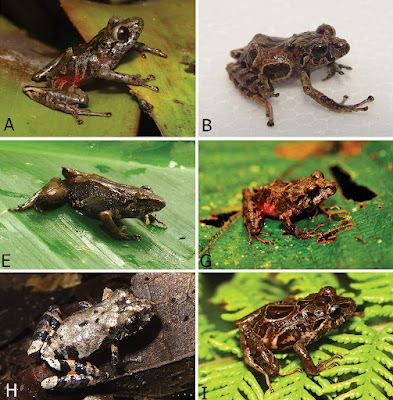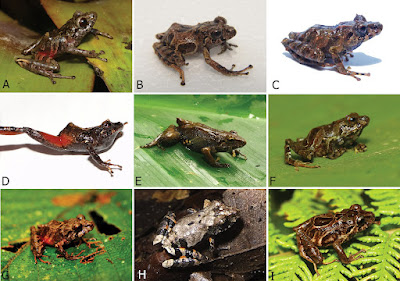Abstract
We present the results of herpetological surveys in two adjacent mountains where the EcoMinga Foundation protects the cloud forest in the Upper Rio Pastaza watershed, in the Llanganates Sangay Ecological Corridor in Ecuador. A rapid assessment of the amphibian communities of the study sites reveals a diverse and heterogeneous composition, dominated by terrestrial frogs from the genus Pristimantis. We also identify a cryptic diversity with a significant number of candidate new species. We describe two new species of terrestrial frogs of the genus Pristimantis. Pristimantis maryanneae sp. nov. is characterised by not having tympanum externally visible and having 2–3 subconical tubercles in the upper eyelid; and Pristimantis burtoniorum sp. nov. is characterised by the presence of red colouration in hidden surfaces of the hind-limbs, tubercles on the upper eyelid, interorbital tubercle and a row of rounded tubercles along the snout to the tip and a pale red venter with dark brown mottled pattern. Our samples from the two Reserves do not share species between them, so the proportion of shared species seems to be relatively low. In addition, we highlight the importance of updating the knowledge of amphibians that are restricted to this important conservation region and comment about the threats and composition of the amphibian communities on the eastern slopes of the Upper Rio Pastaza watershed.
Keywords: Andes, conservation, endemism, Llanganates-Sangay Ecologic Corridor, montane cloud forest, Pristimantis
 |
| Pristimantis maryanneae, live photographs of Paratypes A lateral view and B dorsal view (DHMECN 14452) C lateral view and D dorsal view (DHMECN 14451). Photographs by Mario H. Yánez-Muñoz. |
Pristimantis maryanneae sp. nov
Proposed standard English name: Maryanne’s Robber Frog
Proposed standard Spanish name: Cutín de Maryanne
Diagnosis: Pristimantis maryanneae can be distinguished from other Pristimantis by the following character combination: (1) skin on dorsum finely shagreen, with flat and low warts, weak and fine sacral fold, composed of some low warts, two pairs of scapular tubercles diagonal aligned behind the eye; venter areolate with pustules, discoidal fold present; (2) tympanum absent, hidden beneath the skin; tympanic anulus visible under the skin measuring 25% of the eye diameter; (3) snout short, rounded in dorsal and lateral profile; (4) upper eyelid with 2–3 subconical tubercles (rounded in preservative); upper eyelid wider than interorbital distance; cranial crests absent; (5) dentigerous process of vomer present, oblique in outline with 2–3 oval teeth; (6) males without vocal slits, no nuptial pads; (7) Finger I shorter than II; digital pads expanded; (8) fingers with weakly defined laterals fringes; (9) forearms with small ulnar subconical tubercles; (10) heel bearing a small subconical tubercle; outer edge of tarsus bearing small subconical tubercles, inner tarsal fold absent; (11) two metatarsal tubercles, inner oval twice or three times larger than outer oval that is subconical; (12) toes without lateral fringes; supernumerary tubercles present, Toe V larger than III, does not reach distal subarticular tubercle of Toe IV; (13) dorsal colouration dark grey to grey with green marks, with transverse dark brown marks, with a chevron and irregular “H” shaped marks, flanks with cream diagonal bands, shanks with cream diagonal bands and light brown interspaces, hind-limbs with grey transverse bands and dark brown interspaces; ventral colouration dirty cream with a line along middle of the venter, chin and outer mandibula mottled with dark brown marks, iris light brown to grey with black reticulation and horizontal coppery stripe and (14) SVL males 17.61–17.8 mm; female 21.06mm.
Distribution and natural history: Pristimantis maryanneae is known only from the type locality, Naturetek Vizcaya Reserve, located at Ulba Parish, Baños township, Tungurahua Province, at 2400 m elevation in the eastern versant on the Andes in central Ecuador (Fig. 2), near the southwest limit of Llanganates National Park. This species was found in mature montane cloud forest (MAE 2012), characterised by a canopy of 25 to 30 m covered by epiphytes, orchids, bromeliads, bryophytes, and ferns. The bambusoid grass genus Chusquea was predominant in the area. The five known specimens of Pristimantis maryanneae were found in the lower stratum of the forest, sitting on leaves from 60 to 160 cm; one individual was found in leaf litter during the day, while all others were found on fern leaves at night.
Etymology: Specific epithet is in recognition of Maryanne Mills (née Sawle), a zoologist from Perth, Australia. In 1986, she helped her husband, David Mills, set up the UK’s premier wildlife tour operator, Naturetrek and she has been based in England ever since. Her passion for the environment and its conservation has led Naturetrek to donate widely to this cause, including donations to World Land Trust which allowed EcoMinga Foundation to purchase more than 1,000 acres of Ecuadorian cloud forest, where this new species of terrestrial frog was discovered.
Pristimantis burtoniorum sp. nov.
Proposed standard English name: Burtons’ Robber Frog
Proposed standard Spanish name: Cutín de los Burton
Diagnosis: Pristimantis burtoniorum sp. nov. is distinguished from all congeners by the following combination of characters: (1) skin on dorsum and flanks finely shagreen with a slightly defined mid-dorsal fold, which extends from the tip of the snout to the ventre; skin on ventre areolate, dorsolateral folds absent; discoidal fold present and defined; (2) tympanum present; tympanic membrane and annulus present, equivalent to 25% of the eye diameter; with a single subconic postrictal tubercle; (3) snout large and subacuminate in dorsal and lateral profile; with several small subconic tubercles along the upper mandibulae, more evident in females; (4) upper eyelid with 3–4 large subconic tubercles; one subconic interorbital tubercle, followed by a row of rounded tubercles along middle of the snout; upper eyelid wider than interorbital distance; cranial crests absent; (5) dentigerous process of vomer present, oval in outline with 4–5 teeth oval; (6) males lacking vocal slits, nuptial pads weakly defined; (7) finger I shorter than II ; expanded digital pads, extended in fingers II-IV; two times the width of the digits; (8) fingers with large lateral fringes; (9) forearms with small conic ulnar tubercles; (10) heel with a small conic tubercle; outer border of the tarsus with small conical tubercles, inner tarsal fold present, weakly defined in the first portion; (11) two metatarsal tubercles, inner oval twice size of the outer tubercle that is round-shaped; (12) toes with fine lateral fringes; plantar supernumerary tubercles present, toe V larger than III, not extending further than distal subarticular tubercle of toe IV; (13) dorsal colouration grey with transversal marks dark brown, legs and arms with diagonal bands dark brown with interspaces pink (red in life), flanks with oblique bands finely delineated by cream, hidden surfaces of the venter and groin red; ventral colour grey dense, marked by dark brown, throat and outer mandibulae with dark brown marks, brown-red iris and (14) SVL in males 16.61–17.45 mm; females 20.81–27.03 mm.
Distribution and natural history: Pristimantis burtoniorum is known only from the type locality in the Machay Reserve, Rio Verde Parish, Baños township, Tungurahua Province, Republic of Ecuador (Fig. 2) at an elevation of 2940 m. This locality is comprised of montane cloud forest (MAE 2012), with a canopy of 15 m with a dense layer of bryophytes and epiphytes and an understorey dominated by bromeliads of 30–60 cm in height from the forest floor. This is the predominant microhabitat for Pristimantis burtoniorum; all specimens were found hiding in the base of bromeliads leaves. Sympatric species are Pristimantis festae complex, P. buckleyi complex, Niceforonia sp and Hyloscirtus sp.
Etymology: Species epithet is the genitive plural of “Burton” in Latin, in recognition of John and Viv Burton, who founded and led the World Land Trust for most of its existence. Their impact on nature conservation is worldwide. Without the World Land Trust’s “Forests in the Sky” initiative, it would not have been possible for EcoMinga Foundation to establish the Machay Reserve and complete the Llanganates-Sangay Ecological Corridor.
Juan Pablo Reyes-Puig, Carolina Reyes-Puig, Daniela Franco-Mena, Lou Jost and Mario H. Yánez-Muñoz. 2022. Strong Differentiation between Amphibian Communities on Two Adjacent Mountains in the Upper Rio Pastaza Watershed of Ecuador, with Descriptions of Two New Species of Terrestrial Frogs. ZooKeys. 1081: 35-87. DOI: 10.3897/zookeys.1081.71488



